Hyundai Getz 2007 Owner's Manual
Manufacturer: HYUNDAI, Model Year: 2007, Model line: Getz, Model: Hyundai Getz 2007Pages: 463, PDF Size: 11.14 MB
Page 211 of 463
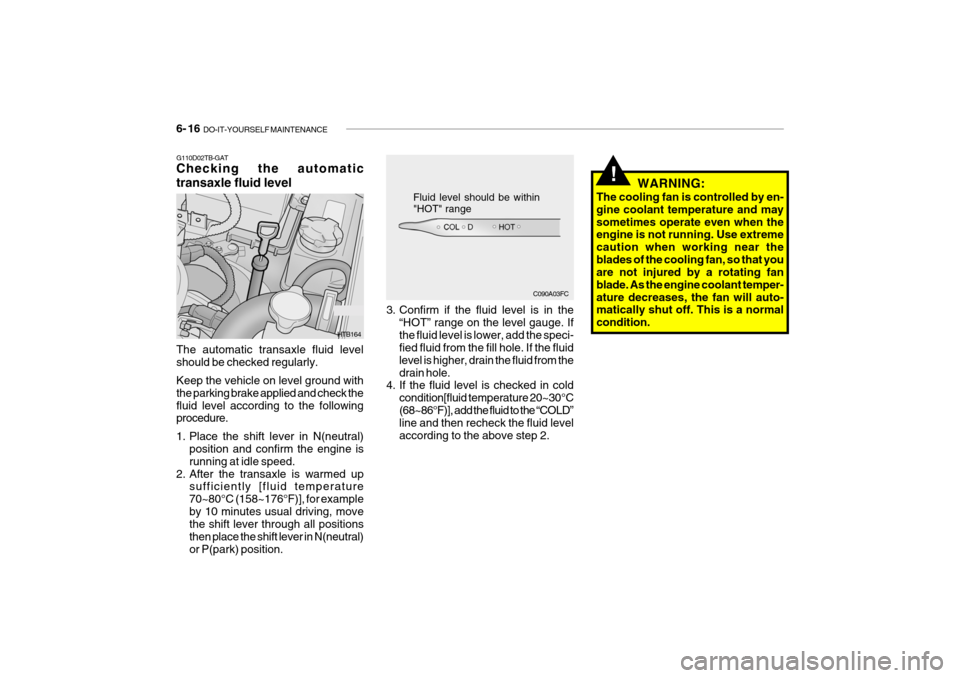
6- 16 DO-IT-YOURSELF MAINTENANCE
WARNING:
The cooling fan is controlled by en- gine coolant temperature and maysometimes operate even when the engine is not running. Use extreme caution when working near theblades of the cooling fan, so that you are not injured by a rotating fan blade. As the engine coolant temper-ature decreases, the fan will auto- matically shut off. This is a normal condition.!
G110D02TB-GAT Checking the automatic transaxle fluid level
C090A03FC
Fluid level should be within "HOT" range
HTB164 3. Confirm if the fluid level is in the
“HOT” range on the level gauge. If the fluid level is lower, add the speci- fied fluid from the fill hole. If the fluid level is higher, drain the fluid from thedrain hole.
4. If the fluid level is checked in cold
condition[fluid temperature 20~30°C(68~86°F)], add the fluid to the “COLD” line and then recheck the fluid level according to the above step 2.
The automatic transaxle fluid levelshould be checked regularly. Keep the vehicle on level ground with the parking brake applied and check thefluid level according to the following procedure.
1. Place the shift lever in N(neutral)
position and confirm the engine is running at idle speed.
2. After the transaxle is warmed up sufficiently [fluid temperature70~80°C (158~176°F)], for exampleby 10 minutes usual driving, move the shift lever through all positions then place the shift lever in N(neutral)or P(park) position.
Page 212 of 463
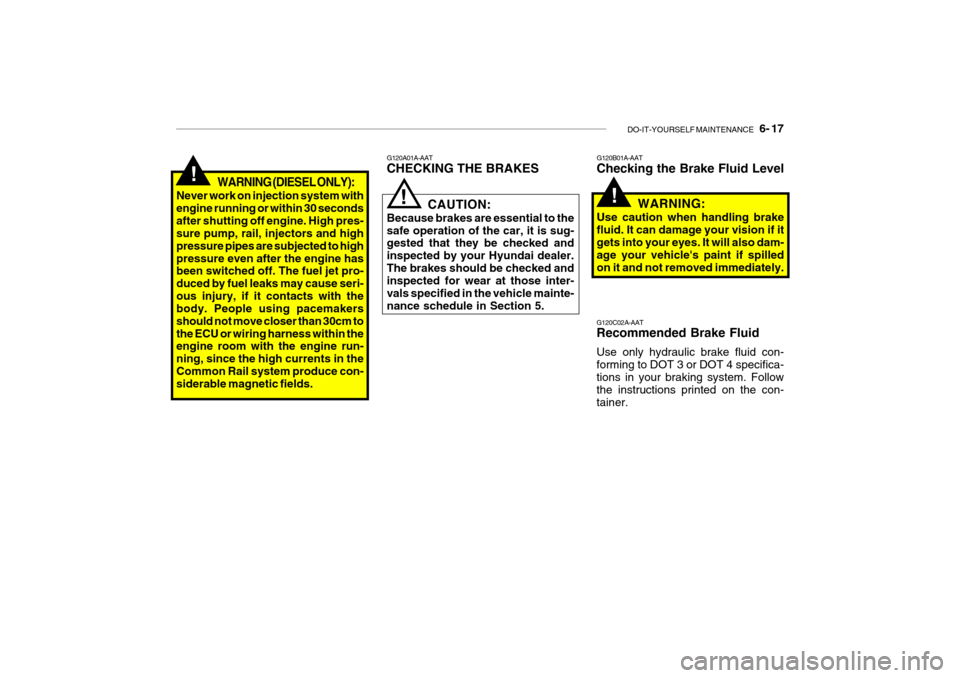
DO-IT-YOURSELF MAINTENANCE 6- 17
WARNING (DIESEL ONLY):
Never work on injection system with engine running or within 30 secondsafter shutting off engine. High pres- sure pump, rail, injectors and high pressure pipes are subjected to highpressure even after the engine has been switched off. The fuel jet pro- duced by fuel leaks may cause seri-ous injury, if it contacts with the body. People using pacemakers should not move closer than 30cm tothe ECU or wiring harness within the engine room with the engine run- ning, since the high currents in the Common Rail system produce con- siderable magnetic fields.
!
G120A01A-AAT CHECKING THE BRAKES G120B01A-AATChecking the Brake Fluid Level
!
CAUTION:
Because brakes are essential to the safe operation of the car, it is sug- gested that they be checked and inspected by your Hyundai dealer.The brakes should be checked and inspected for wear at those inter- vals specified in the vehicle mainte-nance schedule in Section 5. WARNING:
Use caution when handling brakefluid. It can damage your vision if it gets into your eyes. It will also dam- age your vehicle's paint if spilledon it and not removed immediately.!
G120C02A-AAT Recommended Brake Fluid Use only hydraulic brake fluid con- forming to DOT 3 or DOT 4 specifica- tions in your braking system. Follow the instructions printed on the con-tainer.
Page 213 of 463
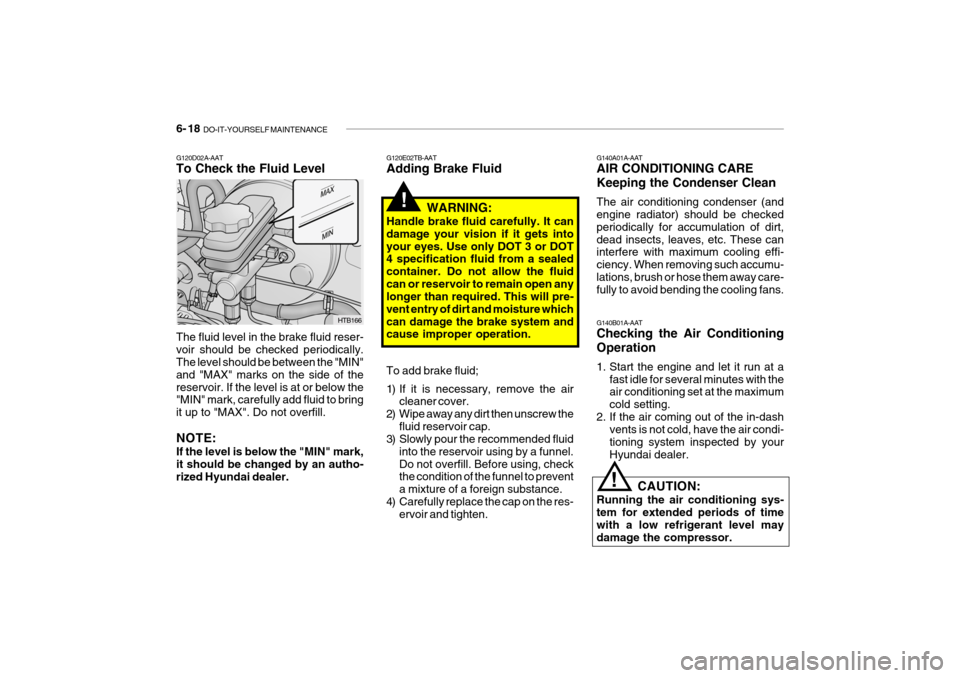
6- 18 DO-IT-YOURSELF MAINTENANCE
G140A01A-AAT AIR CONDITIONING CARE Keeping the Condenser Clean The air conditioning condenser (and engine radiator) should be checked periodically for accumulation of dirt,dead insects, leaves, etc. These can interfere with maximum cooling effi- ciency. When removing such accumu-lations, brush or hose them away care- fully to avoid bending the cooling fans. G140B01A-AAT Checking the Air Conditioning Operation
1. Start the engine and let it run at a
fast idle for several minutes with the air conditioning set at the maximum cold setting.
2. If the air coming out of the in-dash vents is not cold, have the air condi-tioning system inspected by yourHyundai dealer.
! CAUTION:
Running the air conditioning sys- tem for extended periods of timewith a low refrigerant level may damage the compressor.
G120E02TB-AAT Adding Brake Fluid
WARNING:
Handle brake fluid carefully. It can damage your vision if it gets intoyour eyes. Use only DOT 3 or DOT 4 specification fluid from a sealed container. Do not allow the fluidcan or reservoir to remain open any longer than required. This will pre- vent entry of dirt and moisture whichcan damage the brake system and cause improper operation.
!
To add brake fluid;
1) If it is necessary, remove the air cleaner cover.
2) Wipe away any dirt then unscrew the fluid reservoir cap.
3) Slowly pour the recommended fluid
into the reservoir using by a funnel. Do not overfill. Before using, check the condition of the funnel to prevent a mixture of a foreign substance.
4) Carefully replace the cap on the res- ervoir and tighten.
G120D02A-AAT To Check the Fluid Level
HTB166
The fluid level in the brake fluid reser- voir should be checked periodically. The level should be between the "MIN" and "MAX" marks on the side of thereservoir. If the level is at or below the "MIN" mark, carefully add fluid to bring it up to "MAX". Do not overfill. NOTE: If the level is below the "MIN" mark, it should be changed by an autho-rized Hyundai dealer.
Page 214 of 463
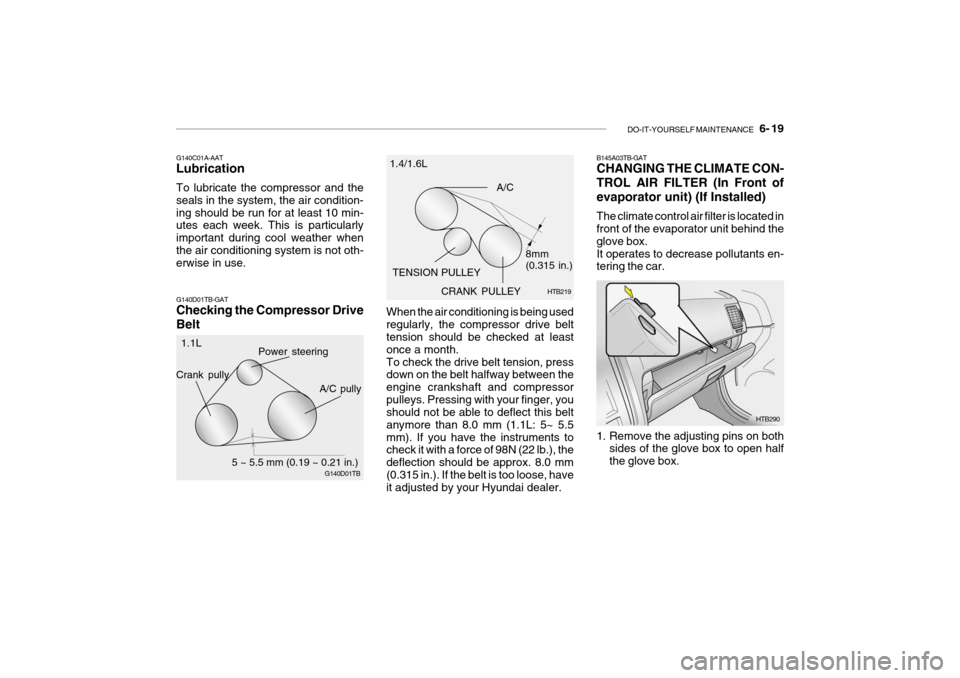
DO-IT-YOURSELF MAINTENANCE 6- 19
G140C01A-AAT Lubrication To lubricate the compressor and the seals in the system, the air condition-ing should be run for at least 10 min- utes each week. This is particularly important during cool weather whenthe air conditioning system is not oth- erwise in use. G140D01TB-GAT Checking the Compressor Drive Belt
G140D01TB
Power steering
Crank pully
A/C pully
5 ~ 5.5 mm (0.19 ~ 0.21 in.)
1.1L
CRANK PULLEY
When the air conditioning is being used regularly, the compressor drive belt tension should be checked at least once a month.To check the drive belt tension, press down on the belt halfway between the engine crankshaft and compressorpulleys. Pressing with your finger, you should not be able to deflect this belt anymore than 8.0 mm (1.1L: 5~ 5.5mm). If you have the instruments to check it with a force of 98N (22 lb.), the deflection should be approx. 8.0 mm(0.315 in.). If the belt is too loose, have it adjusted by your Hyundai dealer. HTB219
A/C
TENSION PULLEY 8mm (0.315 in.)
1.4/1.6L
HTB290
B145A03TB-GAT CHANGING THE CLIMATE CON-
TROL AIR FILTER (In Front ofevaporator unit) (If Installed) The climate control air filter is located in front of the evaporator unit behind the glove box.It operates to decrease pollutants en- tering the car.
1. Remove the adjusting pins on both
sides of the glove box to open half the glove box.
Page 215 of 463
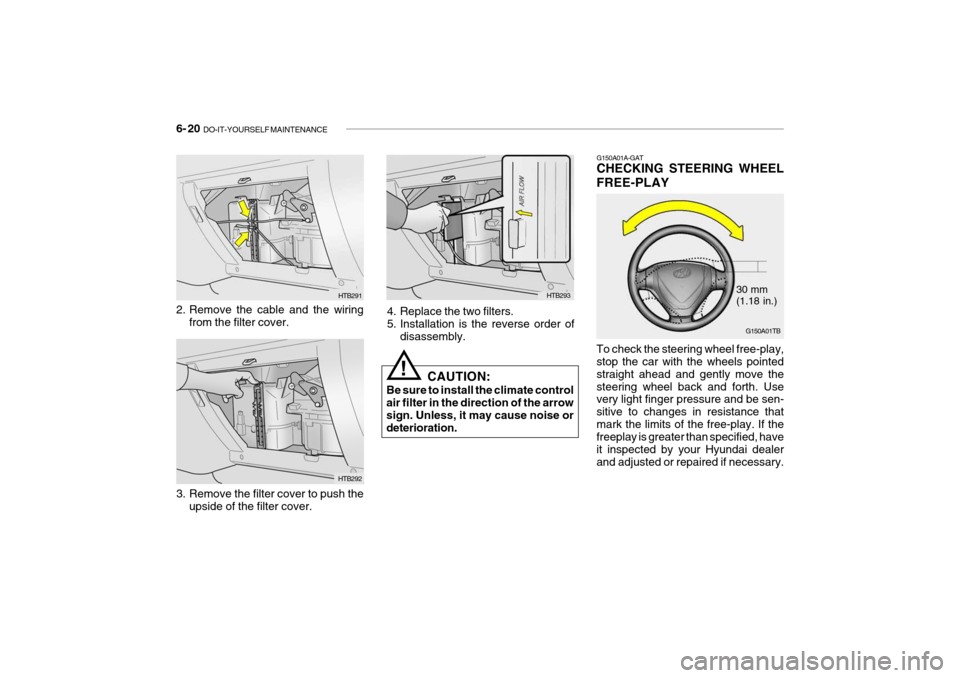
6- 20 DO-IT-YOURSELF MAINTENANCE
HTB293
4. Replace the two filters.
5. Installation is the reverse order of disassembly.
CAUTION:
Be sure to install the climate control air filter in the direction of the arrow sign. Unless, it may cause noise ordeterioration. G150A01A-GAT CHECKING STEERING WHEEL FREE-PLAY To check the steering wheel free-play, stop the car with the wheels pointed straight ahead and gently move thesteering wheel back and forth. Use very light finger pressure and be sen- sitive to changes in resistance thatmark the limits of the free-play. If the freeplay is greater than specified, have it inspected by your Hyundai dealerand adjusted or repaired if necessary.
G150A01TB
30 mm (1.18 in.)
!
HTB291
2. Remove the cable and the wiring from the filter cover.
HTB292
3. Remove the filter cover to push the upside of the filter cover.
Page 216 of 463
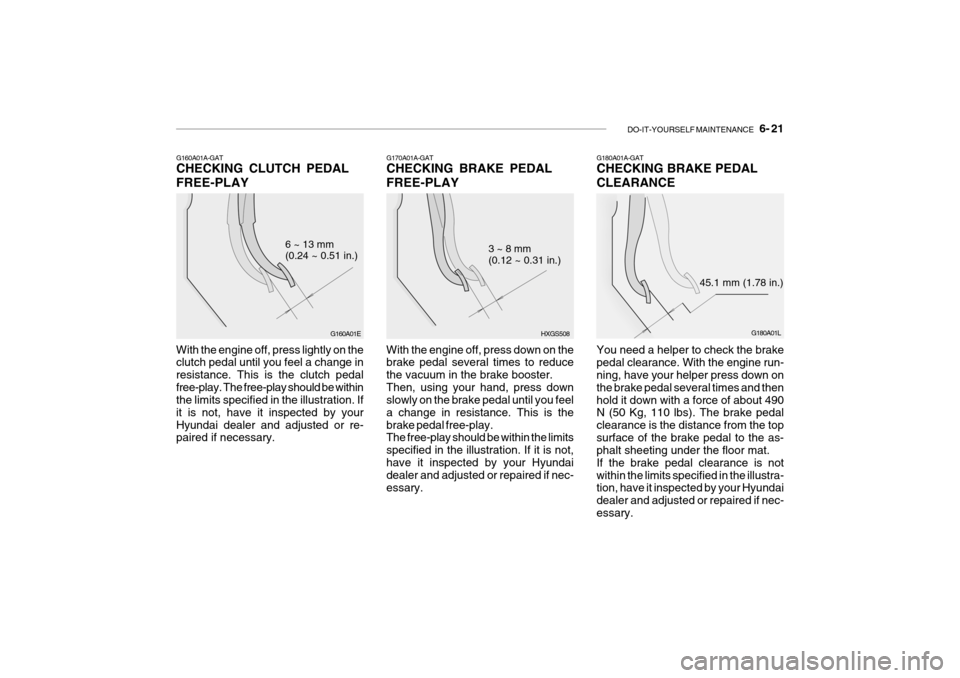
DO-IT-YOURSELF MAINTENANCE 6- 21
G160A01A-GAT CHECKING CLUTCH PEDAL FREE-PLAY
G160A01E
6 ~ 13 mm (0.24 ~ 0.51 in.)
With the engine off, press lightly on the clutch pedal until you feel a change in resistance. This is the clutch pedalfree-play. The free-play should be within the limits specified in the illustration. If it is not, have it inspected by yourHyundai dealer and adjusted or re- paired if necessary.G180A01A-GAT CHECKING BRAKE PEDAL CLEARANCE
G180A01L
45.1 mm (1.78 in.)
You need a helper to check the brake pedal clearance. With the engine run- ning, have your helper press down on the brake pedal several times and thenhold it down with a force of about 490 N (50 Kg, 110 lbs). The brake pedal clearance is the distance from the topsurface of the brake pedal to the as- phalt sheeting under the floor mat. If the brake pedal clearance is notwithin the limits specified in the illustra- tion, have it inspected by your Hyundai dealer and adjusted or repaired if nec-essary.G170A01A-GAT CHECKING BRAKE PEDAL FREE-PLAY
HXGS508
3 ~ 8 mm (0.12 ~ 0.31 in.)
With the engine off, press down on the brake pedal several times to reduce the vacuum in the brake booster.Then, using your hand, press down slowly on the brake pedal until you feel a change in resistance. This is thebrake pedal free-play. The free-play should be within the limits specified in the illustration. If it is not,have it inspected by your Hyundai dealer and adjusted or repaired if nec- essary.
Page 217 of 463
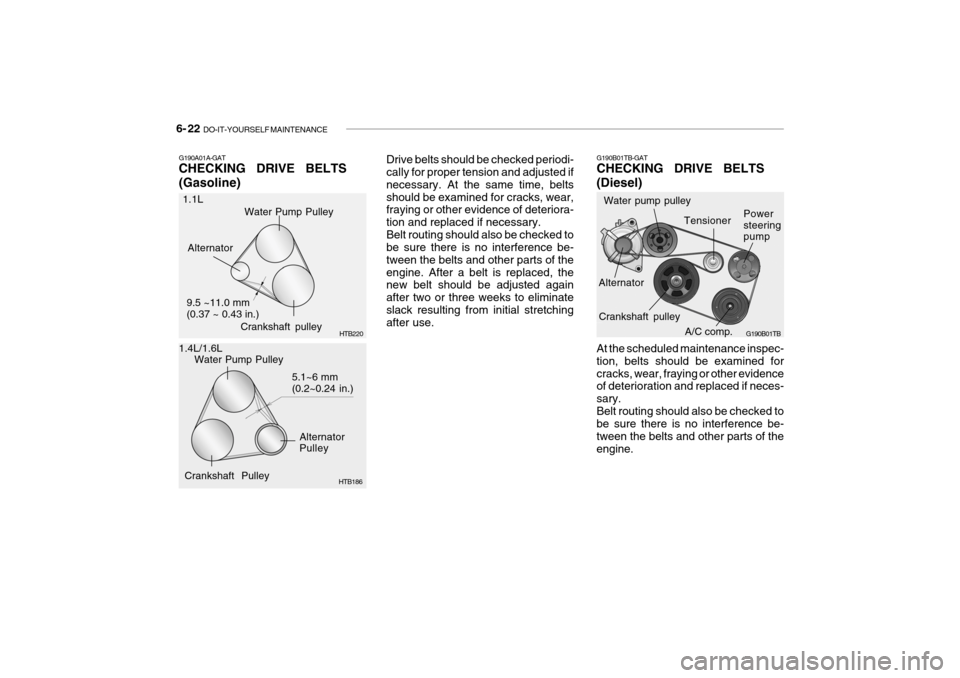
6- 22 DO-IT-YOURSELF MAINTENANCE
Drive belts should be checked periodi- cally for proper tension and adjusted if necessary. At the same time, beltsshould be examined for cracks, wear, fraying or other evidence of deteriora- tion and replaced if necessary.Belt routing should also be checked to be sure there is no interference be- tween the belts and other parts of theengine. After a belt is replaced, the new belt should be adjusted again after two or three weeks to eliminateslack resulting from initial stretching after use. G190B01TB-GAT CHECKING DRIVE BELTS (Diesel)
A/C comp.
Water pump pulley
G190B01TB
Alternator Power steering pump
At the scheduled maintenance inspec- tion, belts should be examined forcracks, wear, fraying or other evidence of deterioration and replaced if neces- sary.Belt routing should also be checked to be sure there is no interference be- tween the belts and other parts of theengine.Water Pump Pulley
Alternator Pulley
Crankshaft Pulley 5.1~6 mm(0.2~0.24 in.)
G190A01A-GAT CHECKING DRIVE BELTS (Gasoline)
HTB186
1.1L
1.4L/1.6L Crankshaft pulley
Alternator
HTB220
Water Pump Pulley
9.5 ~11.0 mm (0.37 ~ 0.43 in.)Tensioner
Crankshaft pulley
Page 218 of 463
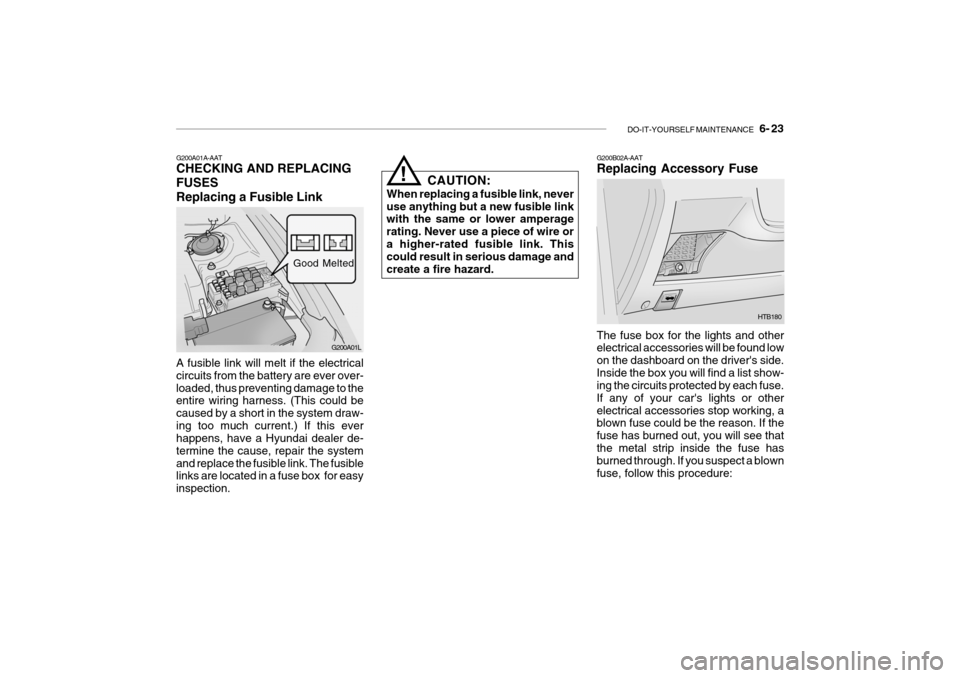
DO-IT-YOURSELF MAINTENANCE 6- 23
G200A01A-AAT CHECKING AND REPLACING FUSESReplacing a Fusible Link
G200A01L
A fusible link will melt if the electrical circuits from the battery are ever over-loaded, thus preventing damage to the entire wiring harness. (This could be caused by a short in the system draw-ing too much current.) If this ever happens, have a Hyundai dealer de- termine the cause, repair the systemand replace the fusible link. The fusible links are located in a fuse box for easy inspection. CAUTION:
When replacing a fusible link, neveruse anything but a new fusible link with the same or lower amperage rating. Never use a piece of wire ora higher-rated fusible link. This could result in serious damage and create a fire hazard.
!
G200B02A-AAT Replacing Accessory Fuse The fuse box for the lights and other electrical accessories will be found low on the dashboard on the driver's side.Inside the box you will find a list show- ing the circuits protected by each fuse. If any of your car's lights or otherelectrical accessories stop working, a blown fuse could be the reason. If the fuse has burned out, you will see thatthe metal strip inside the fuse has burned through. If you suspect a blown fuse, follow this procedure: HTB180
Melted
Good
Page 219 of 463
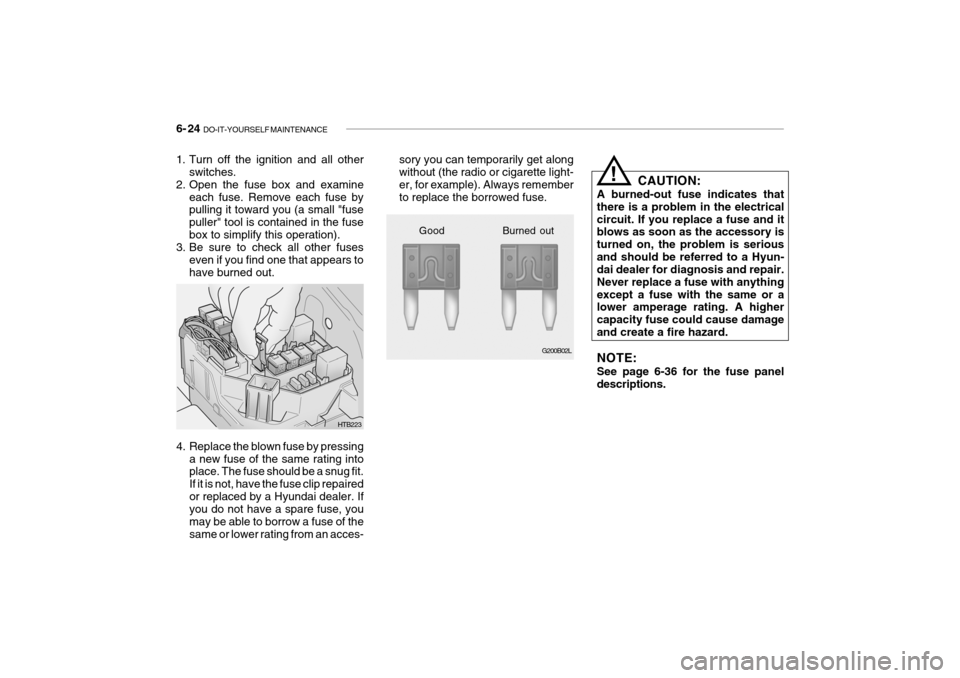
6- 24 DO-IT-YOURSELF MAINTENANCE
sory you can temporarily get along without (the radio or cigarette light- er, for example). Always rememberto replace the borrowed fuse. CAUTION:
A burned-out fuse indicates thatthere is a problem in the electricalcircuit. If you replace a fuse and it blows as soon as the accessory is turned on, the problem is seriousand should be referred to a Hyun- dai dealer for diagnosis and repair. Never replace a fuse with anythingexcept a fuse with the same or a lower amperage rating. A higher capacity fuse could cause damageand create a fire hazard. NOTE: See page 6-36 for the fuse panel descriptions.
!
G200B02L
4. Replace the blown fuse by pressing a new fuse of the same rating into place. The fuse should be a snug fit. If it is not, have the fuse clip repairedor replaced by a Hyundai dealer. If you do not have a spare fuse, you may be able to borrow a fuse of thesame or lower rating from an acces-
1. Turn off the ignition and all other
switches.
2. Open the fuse box and examine each fuse. Remove each fuse by pulling it toward you (a small "fuse puller" tool is contained in the fusebox to simplify this operation).
3. Be sure to check all other fuses
even if you find one that appears tohave burned out.
HTB223Good B
urned out
Page 220 of 463
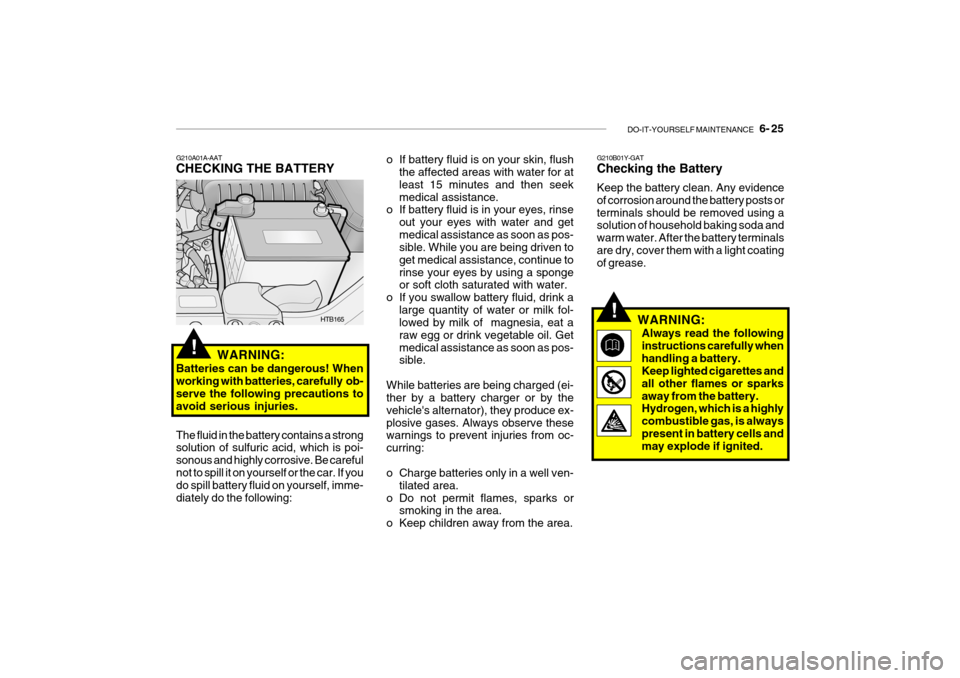
DO-IT-YOURSELF MAINTENANCE 6- 25
G210A01A-AAT CHECKING THE BATTERY
WARNING:
Batteries can be dangerous! When working with batteries, carefully ob-serve the following precautions to avoid serious injuries. HTB165
The fluid in the battery contains a strongsolution of sulfuric acid, which is poi- sonous and highly corrosive. Be carefulnot to spill it on yourself or the car. If you do spill battery fluid on yourself, imme- diately do the following:
!
o If battery fluid is on your skin, flush the affected areas with water for at least 15 minutes and then seekmedical assistance.
o If battery fluid is in your eyes, rinse
out your eyes with water and getmedical assistance as soon as pos- sible. While you are being driven to get medical assistance, continue torinse your eyes by using a sponge or soft cloth saturated with water.
o If you swallow battery fluid, drink a large quantity of water or milk fol-lowed by milk of magnesia, eat a raw egg or drink vegetable oil. Getmedical assistance as soon as pos- sible.
While batteries are being charged (ei-ther by a battery charger or by the vehicle's alternator), they produce ex-plosive gases. Always observe these warnings to prevent injuries from oc- curring:
o Charge batteries only in a well ven- tilated area.
o Do not permit flames, sparks or smoking in the area.
o Keep children away from the area.
!
G210B01Y-GAT Checking the Battery Keep the battery clean. Any evidence of corrosion around the battery posts orterminals should be removed using a solution of household baking soda and warm water. After the battery terminalsare dry, cover them with a light coating of grease.
WARNING:
Always read the following instructions carefully whenhandling a battery. Keep lighted cigarettes and all other flames or sparksaway from the battery. Hydrogen, which is a highly combustible gas, is alwayspresent in battery cells and may explode if ignited.